

Car insurance is one of the biggest costs associated with owning and operating a vehicle. That’s why when it comes to taking out coverage, it can be tempting to go with the cheapest option. But cheaper doesn’t necessarily mean better, especially when it comes to getting the right protection. Apart from the price, there are a host of other factors you need to consider in securing the best deal possible.
In this car insurance comparison guide, Insurance Business gives you a side-by-side assessment of the country’s largest auto insurers. Besides rates, we will look deeper into what features and benefits their policies offer and how these companies perform in terms of customer service and claims handling.
Insurance buyers can use this guide to find the coverage that fits their needs. Industry professionals, on the other hand, can get an idea of how their products fare against the competition.
One of the benefits of taking out coverage from an established car insurance brand is knowing that it has the financial means to pay for your claims. Many of the leading insurers also boast decades of industry experience. This means they can offer a diverse range of coverage options to fit different types of drivers.
The 10 largest car insurance providers in the US control more than three-quarters of the market, which shows the vastness of their reach. The table below ranks the 10 biggest car insurers in the country based on the latest market share data from the National Association of Insurance Commissioners (NAIC).
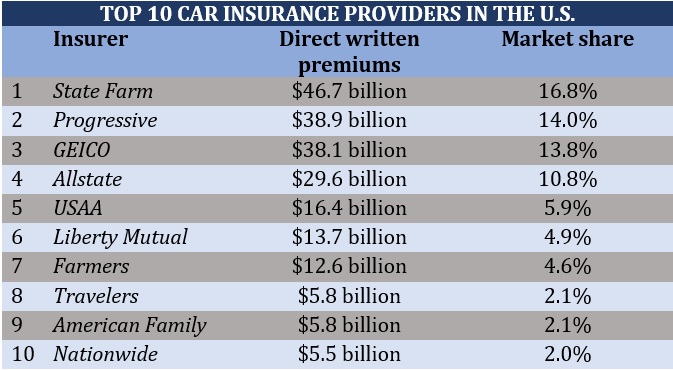
If you want to learn more about these insurers, you can check out our rankings of the top 10 car insurance companies in the US.
One way of making sure that you’re getting the best value for your money is to compare car insurance rates. Because your circumstances vary from those of other drivers, the simplest and easiest way to go about it is to use car insurance comparison sites. These websites allow you to get customized quotes that match your coverage needs.
In the tables below, we will give you an estimate of how much car insurance policies from the country’s leading insurers cost based on different variables. To come up with the figures, Insurance Business gathered data from various price comparison websites.
These tables give readers an idea of how much rates can vary between insurance providers. Because car insurance is a highly individualized type of policy, the premiums you’re required to pay may be significantly higher or lower than the numbers below.
Your age has a major impact on your car insurance rates. Younger drivers typically pay the highest premiums as age often correlates with driving experience and the risk of getting into an accident.
Here’s the average cost of basic and full coverage from the country’s largest insurers for a 20-year-old driver and a 30-year-old motorist:
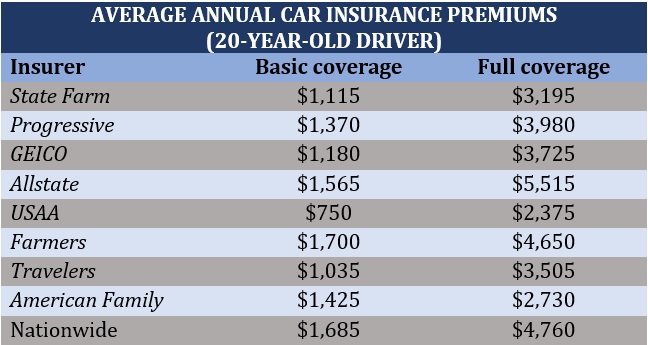
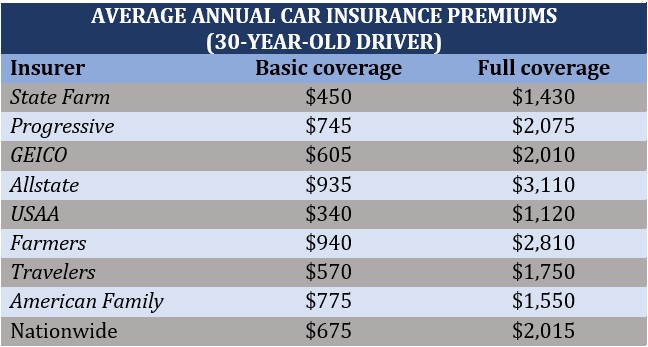
Based on the figures above, the average rates for 20-year-old drivers are often more than double than those of their 30-year-old counterparts. Premiums usually go down as a driver reaches around 40 to 50 years old but rises again as they reach senior age.
And while USAA offers the lowest rates hands down, its policies are only accessible to active members of the military, veterans, and their families.
Also, Liberty Mutual isn’t included in our car insurance comparison tables as the company doesn’t publicly disclose rates. The mutual insurer can provide quotes based on your driving profile and coverage needs, but you will need to contact the company directly.
Your driving history is another huge factor that insurers look into when determining premiums.
If you’re a safe driver, insurers will typically reward you with lower rates and access to various discounts. Major traffic infractions and at-fault accidents, however, can drive up your rates considerably.
Here’s how a DUI citation and an at-fault accident can affect average full coverage rates from the top car insurance companies in the US:
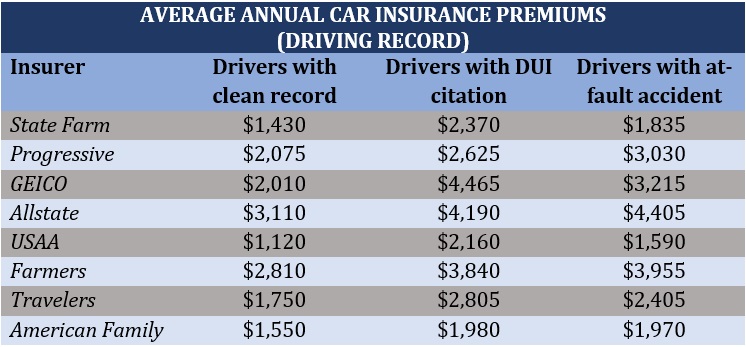
These numbers show how a DUI citation can push up car insurance rates by about 75%. This type of violation also stays on your record for three to 10 years, depending on the state.
For at-fault accidents, the top insurance companies raise premiums between 30% and 60%. State Farm and American Family impose the lowest increases, while GEICO charges the most for drivers who caused a collision.
Most states allow car insurers to use credit-based auto insurance scores to help determine premiums. This is because drivers with high ratings tend to file fewer claims than those with lower credit scores. If you have a good credit history, insurance companies will often give you cheaper rates.
This car insurance comparison table shows the difference between the premiums of motorists with good credit ratings and those who don’t.
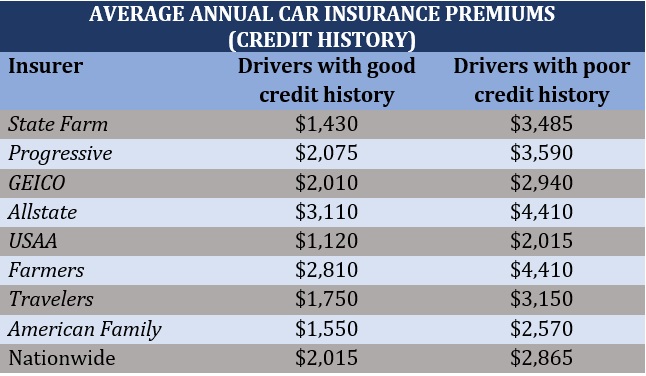
Almost all insurers charge motorists with poor credit ratings more than double compared to their counterparts with good credit history. This shows how car insurance companies put a premium on how well you manage your finances.
You can check out our comprehensive guide to car insurance quotes to view rates from a wider range of insurers.
Car insurance companies offer a range of policy inclusions and benefits to set them apart from industry rivals. The table below lists the various coverage options the top insurers provide, along with some of their unique discount offerings:
|
CAR INSURANCE COMPARISON (POLICY FEATURES) |
||
|---|---|---|
|
Insurer |
Coverage options |
Discount options |
|
State Farm |
|
|
|
|
|
|
GEICO |
|
|
|
|
|
|
USAA |
|
|
|
Liberty Mutual |
|
|
|
|
|
|
|
|
|
|
|
|
|
|
Car insurance may seem like a straightforward form of protection, but there are several layers that make coverage complex. If you want to understand how this type of policy works, you can check out this guide to car insurance.
Customer satisfaction is another important factor to consider when searching for car insurance. Read client reviews and industry surveys or speak with other customers to get a picture of how an insurer handles claims and other client concerns.
This car insurance comparison table shows the customer satisfaction ratings of the country’s largest auto insurers based on the latest survey by the global consumer intelligence firm J.D. Power. This list is arranged from the highest to the lowest scores. The industry average rating is 873.
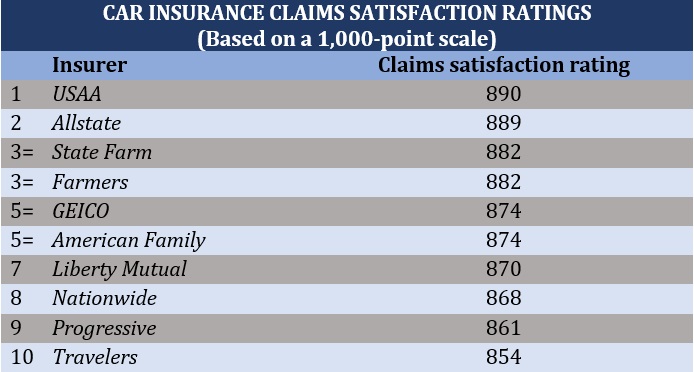
Interested in more insurance data? Subscribe to the IB+ Data Hub and unlock cutting-edge data in our powerful, interactive dashboard.
The Insurance Information Institute (Triple-I) recommends that you do a car insurance comparison of at least three insurers before settling on the one with the best policy.
Apart from the price, the institute suggests that you look at three major factors:
If you want to get additional tips on how to save on premiums without sacrificing quality, then this comprehensive guide to cheap car insurance is for you.
Have you done a car insurance comparison lately? Which auto insurers do you think offer the best coverage? Share your thoughts in the comments section below.
